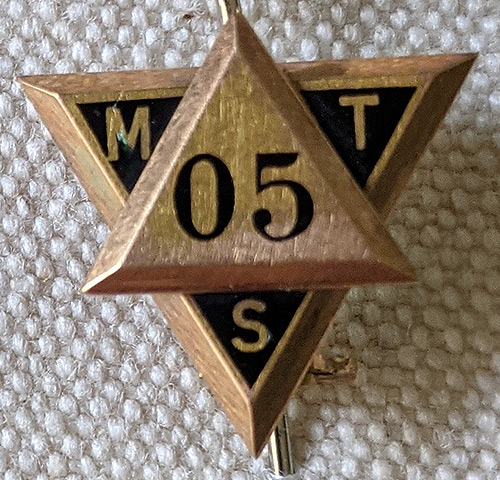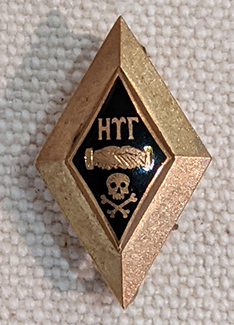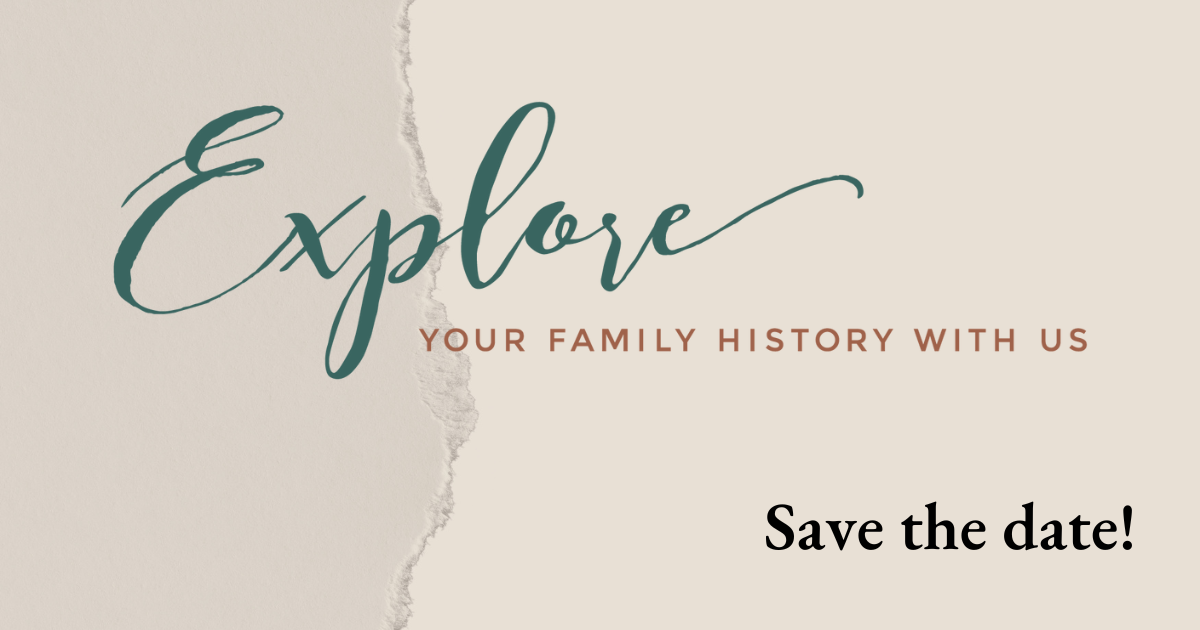Finding genealogical clues in service pins, medals, and keys

by Susan Chance-Rainwater

When my grandmother died, Dad gave me her jewelry box and told me to take anything I wanted. What I chose was a jumble of service pins.
I knew the 1918 Maryland State Normal School class pin was my grandmother’s. The Frigidaire BTU Club dealer pin clearly belonged to my grandfather, known in the Wilmington area as ‘Carload Pete’ because of his colorful radio commercials that always started with the words “We’ve got a carload of brand new appliances just in at Wilmington Appliance.”
So what was I to make of a Foreign Legion pin and military-looking pin with the letters AEF? How about the diamond-shaped pin containing three Greek letters, shaking hands, and a skull and crossbones? Was someone in my family a member of a sinister secret society? Finally, what was the double‑triangle pin with the letters MTS and the numbers 05? Four interesting mysteries.
What are service pins, medals, and keys?
Many of our ancestors were joiners, and signified their membership by wearing pins or keys. If your ancestors graduated from almost any school, they received class pins. If they joined a social or academic fraternity or sorority, they got pins. Community organizations and churches awarded pins. So did some employers. Clubs, unions, veterans’ organizations, trade groups, the Masons and other fraternal societies, political parties, Boy and Girl Scouts, civic and government groups – all of them generated pins.
Keys are the older version of pins, popular in an era when most men wore pocket watches on a chain. In photos from the late 19th or early 20th century, it’s not unusual to see a key – a rectangle with a loop at the top and a spire at the bottom – dangling from a man’s watch chain.
Medals require less explanation. Military medals certainly come to mind, but I’m thinking of academic medals. Debate society, spelling bees, science fairs, and athletic competitions are common sources of medals your ancestor might have received in school. My brother‑in‑law received an American Legion school medal for completing a patriotism education program. I’m sure you can think of many that I haven’t listed here.
A collection of these artifacts can provide clues to what your ancestor cared about, joined, believed, and volunteered for. These little bits of cloth, metal and enamel can add new insights to your family research.
Identifying your pin
I started with the diamond-shaped secret society pin, because, seriously, a skull and crossbones?
If you have a mystery pin, start by photographing it. Then make a list of every identifiable characteristic. In the case of my pin, here’s what I knew:

- Shape – diamond – gold outer rim, inner black enamel
- Size – about ¾” high
- Greek letters
- Shaking hands
- Skull and crossbones
- Pin and c-clasp on the back
The most important clue were the Greek letters – Eta Upsilon Gamma – which I figured out from a chart in a dictionary. Because my initial research was pre‑Google and pre‑Wikipedia, I posted a photo on my personal website and asked for suggestions.
About six months later, an individual known to me only as Drew, recommended Bairds’ Manual of American College Fraternities. A single edition, the 12th, contained an entry for Eta Upsilon Gamma, a women’s junior college sorority that existed between 1901-1929, primarily in Missouri. So thanks to Drew, I knew what the pin was, but not the connection. I didn’t think I had any family in Missouri. It’s worth noting that even today, there’s not much online regarding this short-lived sorority. Baird’s was and is the definitive resource.
Today, in addition to posting on my own website, I would post on social media platforms like Facebook, Instagram, and Reddit, and engage experts at local genealogical societies, like the DGS. I’d also search websites like eBay and Etsy, both of which sell lots of old pins. Books on antique jewelry, available in the Dallas Public Library, can help identify and date the clasp type.
I identified the AEF pin a few years later with the help of the new search engine, Google. AEF stands for American Expeditionary Force, the name given to the American units that fought in World War I. The Foreign Legion pin likely referred to the same military service. Small problem – no one on Dad’s side had served in World War I.
In 2016, when my step-mother Prue died, I decided to flesh out my research on her family, because there’s nothing like waiting to start your research until after you can no longer ask questions of the living. In the process, I realized who these three pins belonged to. My grandmother’s jewelry box had become a dumping ground for miscellaneous jewelry. Three of the mystery pins belonged to my step‑mother’s parents. Her father, Archibald Wyatt, had served in World War I. Her step‑mother, Geraldine Meyer Wyatt, was the member of Eta Upsilon Gamma. Prue and her parents were from Missouri.

The Masons’ policy on “equipment”
This left me with one mystery – the MTS 05 pin. One of the possibilities I initially considered was that “M” stood for Masons, so I contacted the Dallas Scottish Rite Library. I had left a voice mail, and on the return call, the person I spoke with said he “understood that I wanted to return some equipment.” What I learned is the Masons hold that pins, rings, chain collars, and other evidences of membership belong to them. If you aren’t personally a Mason, you’re expected to return your ancestor’s Masonic items to the local chapter. Since the man I spoke with couldn’t identify the pin, we agreed that it wasn’t theirs.
Renewing the search for MTS 05
As part of writing this article, I made a renewed effort to identify MTS 05. Here’s what I know:
- Shape – two triangles stacked atop each other
- Size – ½”, from point to point
- Brass or gold metal
- Bottom triangle – black enamel, with gold letters M T S embedded
- Top triangle – metal with the black number 05 embedded
- Pin and c-clasp with buckle
- Manufacturer’s mark – Mermod Jaccard
My trusty copy of Rainwater’s Encyclopedia of Silver Manufacturers informed me that Mermod Jaccard was a St. Louis jewelry company, so this pin is probably from the Missouri side of the family. The “05” may be 1905, but could mean Chapter No. 5. “T S” could mean technical school, theological seminary, or temperance society, among other possibilities.
One of the resources for identifying pins and keys are the catalogs of the jewelry companies themselves. Through Worldcat.org, I learned that The Illustrated Catalog of the Mermod Jaccard Company was held by three St. Louis libraries. There was also one available on eBay, so I bought it. Unfortunately, though it contained an impressive number of organizational pins, there was nothing resembling this pin.
I also sent inquiries to the St. Louis Genealogical Society Facebook page and The State Historical Society of Missouri; sadly without results.
In July 2021, eBay seller Genuine Treasure offered a pin described as an “MTS fraternal order pin” made by the Robbins Company. The photo showed a triangle with the letters M-T-S in the corners. In the middle, was an open book and the words “Boží Slovo.” Google Translate renders Boží Slovo as “the word of God” in Czech (or Russian if you leave out the diacritical marks). The design has common elements, but isn’t the same pin or made by the same manufacturer. It may be an earlier or later design for the same organization. It’s the only pin even remotely similar to mine that I have ever seen.
The problem of unsavory organizations
In the course of your research, it’s possible you will unearth relatives who belonged to unsavory organizations. I have a couple of distant relations who were members of the Junior Order of United American Mechanics, a nativist, anti-immigration, anti-Catholic group founded in the 1840s that lasted into the 20th century. Their pins have a vaguely Masonic design, though the organization wasn’t affiliated with the Masons in any way.
Other reprehensible groups whose members wore insignia include the Ku Klux Klan, American Protective League, Patriotic Order Sons of America, National Security League, and America First Committee (rings), whose most famous member was Charles Lindbergh. Sadly, there are numerous similar groups.
How you handle your relatives’ membership in unsavory organizations is a judgment call. What informs this decision is your approach to including or excluding negative information in your genealogy. If your instinct is to present an entirely positive picture of your relations, you may want to ignore these pins. If you take a “warts and all” approach, you may want to acknowledge your relation’s unfortunate beliefs. I’m in the latter camp.
In conclusion
It was probably in the late 1990s when I mentioned to Dad how much I was learning from my grandparents’ pins and keys. He promptly mailed me a collection of his own. In among the ones I expected – honor society, fraternity, student government, theater club – was one I hadn’t. Dad had served in some capacity on the Delaware Bicentennial Commission in 1976. I had been away at college, so I hadn’t known. The things you learn from pins.
Key to the illustrations
All of the pins in this article are from my personal collection. They are:
- Left to right: American Expeditionary Force (Archibald Wyatt); Phi Kappa Phi honor society (Elbert Chance); 1918 Maryland State Normal School class pin (Louise Marshall Chance); 1923 Philadelphia Swim Club medal, 1st place, 220 yard scholastic (Edward Bardo); 1919 Faulkner School class pin (Margaret Buckley Bardo); GM/Frigidaire BTU Club dealer pin (Pete Chance); American Legion school medal (Randy Rainwater); 1965 Girl Scouts World Association pin (Susan Chance‑Rainwater)
- Eta Upsilon Gamma sorority pin (Geraldine Meyer Wyatt)
- MTS 05 pin (still a mystery!)
© 2021 Susan Chance-Rainwater
Published by Dallas Genealogical Society with the author’s permission

